child lock CHEVROLET TRACKER 1998 1.G Owners Manual
[x] Cancel search | Manufacturer: CHEVROLET, Model Year: 1998, Model line: TRACKER, Model: CHEVROLET TRACKER 1998 1.GPages: 386, PDF Size: 21.17 MB
Page 25 of 386
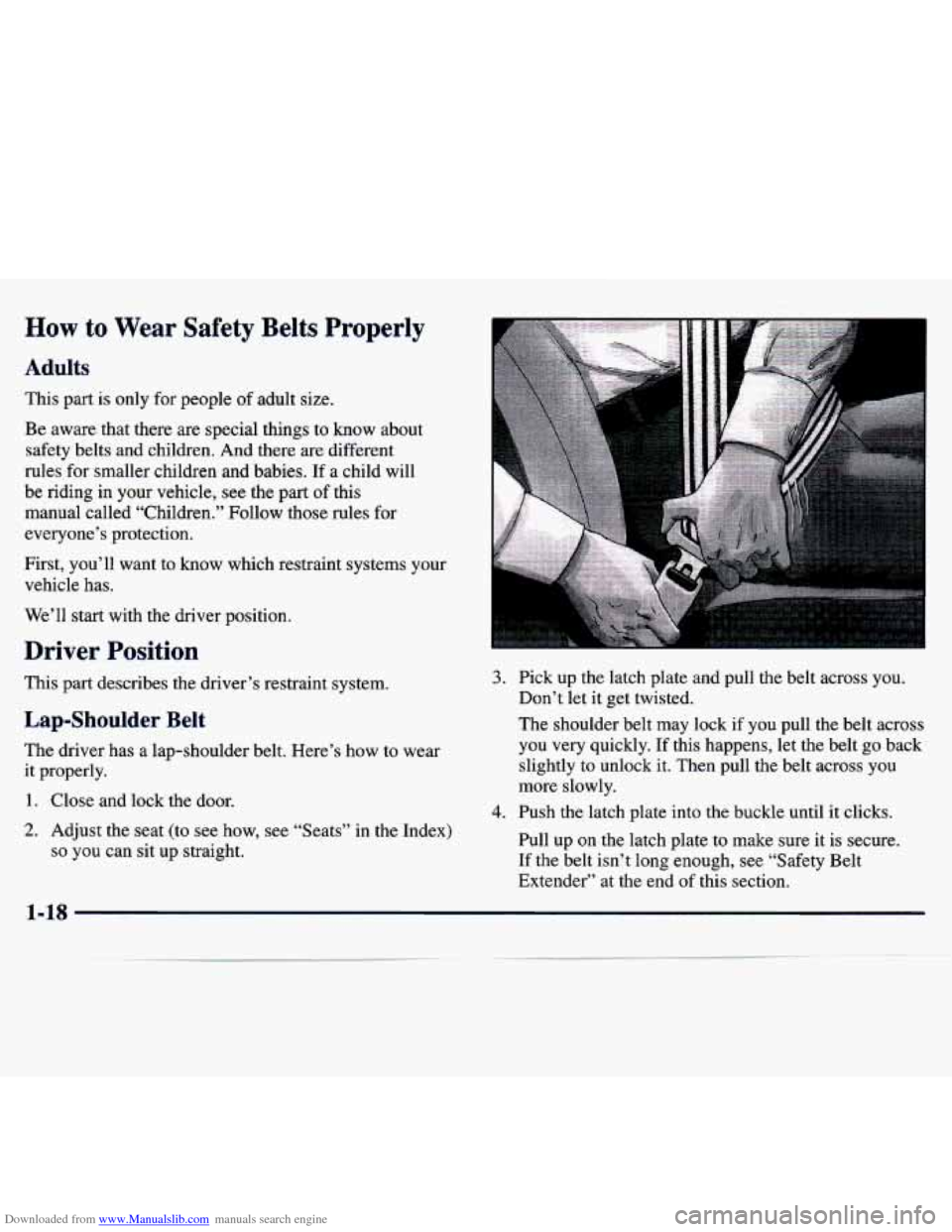
Downloaded from www.Manualslib.com manuals search engine How to Wear Safety Belts Properly
Adults
This part is only for people of adult size.
Be aware that there are special things to know about
safety belts and children. And there are different
rules for smaller children and babies. If
a child will
be riding in your vehicle, see the part of this
manual called “Children.” Follow those rules for
everyone’s protection.
First, you’ll want to know which restraint systems your
vehicle has.
We’ll start
with the driver position.
Driver Position
This part describes the driver’s restraint system.
Lap-Shoulder Belt
The driver has a lap-shoulder belt. Here’s how to wear
it properly.
1. Close and lock the door.
2. Adjust the seat (to see how, see “Seats” in the Index)
so you can sit up straight.
3. Pick up the latch plate and pull the belt across you.
Don’t let it get twisted.
The shoulder belt may lock
if you pull the belt across
you very quickly. If this happens, let the belt
go back
slightly to unlock it. Then pull the belt across you
more slowly.
4. Push the latch plate into the buckle until it clicks.
Pull up on the latch plate to make sure it is secure.
If the belt isn’t long enough, see “Safety Belt
Extender” at the end of this section.
Page 32 of 386
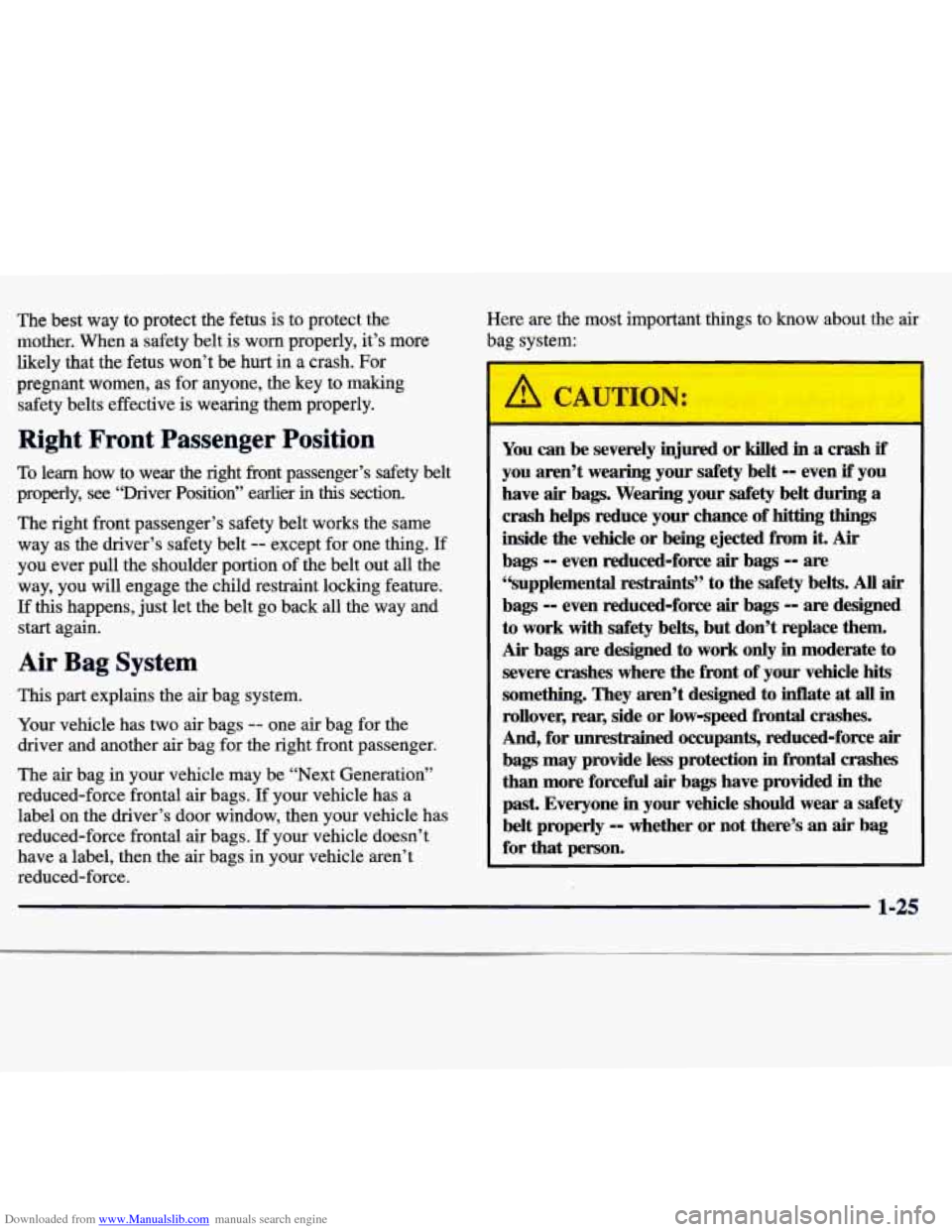
Downloaded from www.Manualslib.com manuals search engine The best way to protect the fetus is to protect the
mother. When
a safety belt is worn properly, it’s more
likely that the fetus won’t be hurt in a crash. For
pregnant women, as for anyone, the key
to making
safety belts effective
is wearing them properly.
Right Front Passenger Position
To learn how to wear the right front passenger’s safety belt
properly,
see “Driver Position” earlier in this section.
The right front passenger’s safety belt works the same
way as
the driver’s safety belt -- except for one thing. If
you ever pull the shoulder portion of the belt out all the
way, you will engage the child restraint locking feature.
If this happens, just let the belt go back all the way and
start again.
Air Bag System
This part explains the air bag system.
Your vehicle has two air bags
-- one air bag for the
driver and another air bag for the right front passenger.
The air bag in your vehicle may be “Next Generation”
reduced-force frontal ak bags. If your vehicle has a
label on the driver’s door window, then your vehicle has
reduced-force frontal air bags. If your vehicle doesn’t
have a label, then the
air bags in your vehicle aren’t
reduced-force. Here
are the
most important things to know about the air
bag system:
You can be severely injured or killed in a crash if
you aren’t wearing your safety belt -- even if you
have
air bags. Wearing your safety belt during a
crash helps reduce your chance of bitting
things
inside the vehicle or being ejected from it. Air
bags -- even reduced-force air bags -- are
“supplemental restraints” to the safety belts. All air
bags -- even reduced-force air bags -- are designed
to work with safety belts, but don’t replace them.
Air bags are designed to work only in moderate to
severe crashes where the front of your vehicle hits
something. They aren’t designed to Mate at all in
rollover, rear, side or low-speed frontal crashes.
And, for
unrestrained occupants, reduced-force air
bags may provide less protection in frontal crashes
than more forcefid
air bags have provided in the
past. Everyone
in your vehicle should wear a safety
belt properly
-- whether or not there’s an air bag
for that person.
1-25
Page 52 of 386

Downloaded from www.Manualslib.com manuals search engine 4. Pull the rest of the shoulder belt all the way out of
the retractor to set the lock. 5. To tighten the belt, feed the shoulder belt back into
the retractor while
you push down on the child
restraint.
If you’re using a forward-facing child
restraint, you may find it helpful to use your knee
to push down on the child restraint
as you tighten
the belt.
6. Push and pull the child restraint in different
directions to be sure
it is secure.
1-45
Page 54 of 386

Downloaded from www.Manualslib.com manuals search engine 3. Pick up the latch plate, and run the lap and shoulder
portions
of the vehicle’s safety belt through or
around the restraint. The child restraint instructions
will show you how.
If the shoulder belt goes in front
of the child’s face or
neck, put it behind the child restraint.
4. Buckle the belt. Make sure the release button is
positioned
so you would be able to unbuckle the
safety belt quickly if you ever had
to.
5. Pull the rest of the shoulder belt all the way out of
the retractor
to set the lock.
1-47
Page 63 of 386
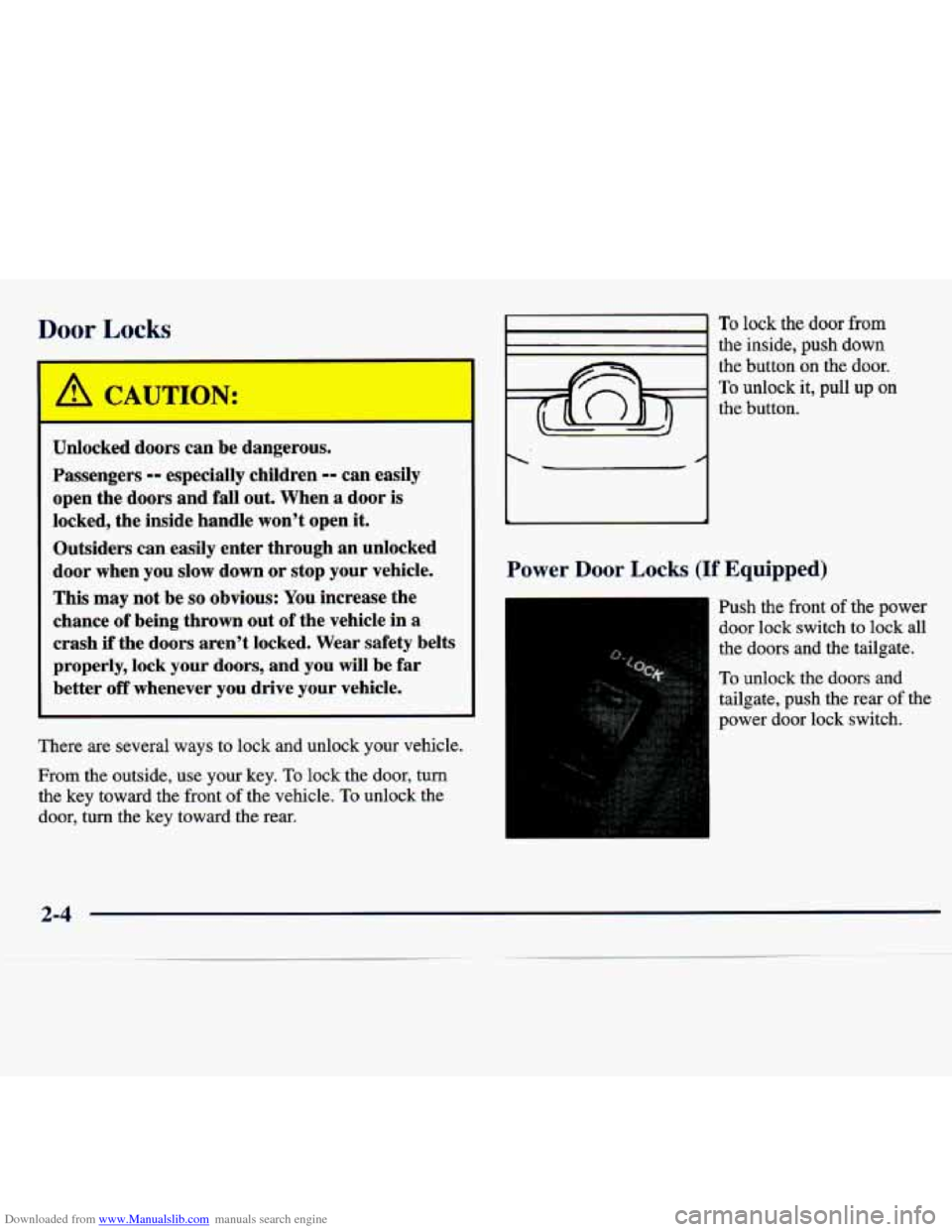
Downloaded from www.Manualslib.com manuals search engine Door Locks
Unlocked doors can be dangerous.
Passengers
-- especially children -- can easily
open the doors and fall out. When
a door is
locked, the inside handle won’t open it.
Outsiders can easily enter through an unlocked
door when you slow down or stop your vehicle.
This may not be
so obvious: You increase the
chance of being thrown out of the vehicle in
a
crash if the doors aren’t locked. Wear safety belts
properly, lock your doors, and you will be far
better
off whenever you drive your vehicle.
There are several
ways to lock and unlock your vehicle.
From the outside, use your key.
To lock the door, turn
the key toward the front of the vehicle.
To unlock the
door, turn the key toward the rear.
1
To lock the door from
the inside, push down
the button on the door.
To unlock it, pull up on
the button.
Power Door Locks (If Equipped)
Push the front of the power
door lock switch to lock all
the doors and the tailgate.
To unlock the doors and
tailgate, push the rear of the
power door lock switch.
2-4
Page 64 of 386

Downloaded from www.Manualslib.com manuals search engine Rear Door Security Locks (4-DOOr Models)
Your vehicle is equipped
with rear door security
locks that help prevent
passengers from opening
the rear doors of your
vehicle from the inside.
To use one of these locks:
1. Move the lever down to engage the lock.
2. Close the door.
3. Do the same to the other rear door lock.
The rear doors of your vehicle cannot be opened from
the inside when this feature is in use. If
you want to open a rear door when the security
lock is
on, unlock the door from the inside, then open the door
from the outside.
If you
don’t cancel the security lock feature, adults or
older children who ride in the rear won’t be able to open
the rear door from the inside.
You should let adults and
older children know how these security locks work, and
how to cancel the locks.
To cancel the rear door lock:
1. Unlock the door from the inside and open the door
from the outside.
2. Move the lever up to disengage the lock.
3. Do the same for the other rear door.
The rear door locks will now work normally.
Leaving Your Vehicle
If you are leaving the vehicle, take your key, open your
door and set the locks from inside. Then get
out and
close the door.
2-5
Page 156 of 386
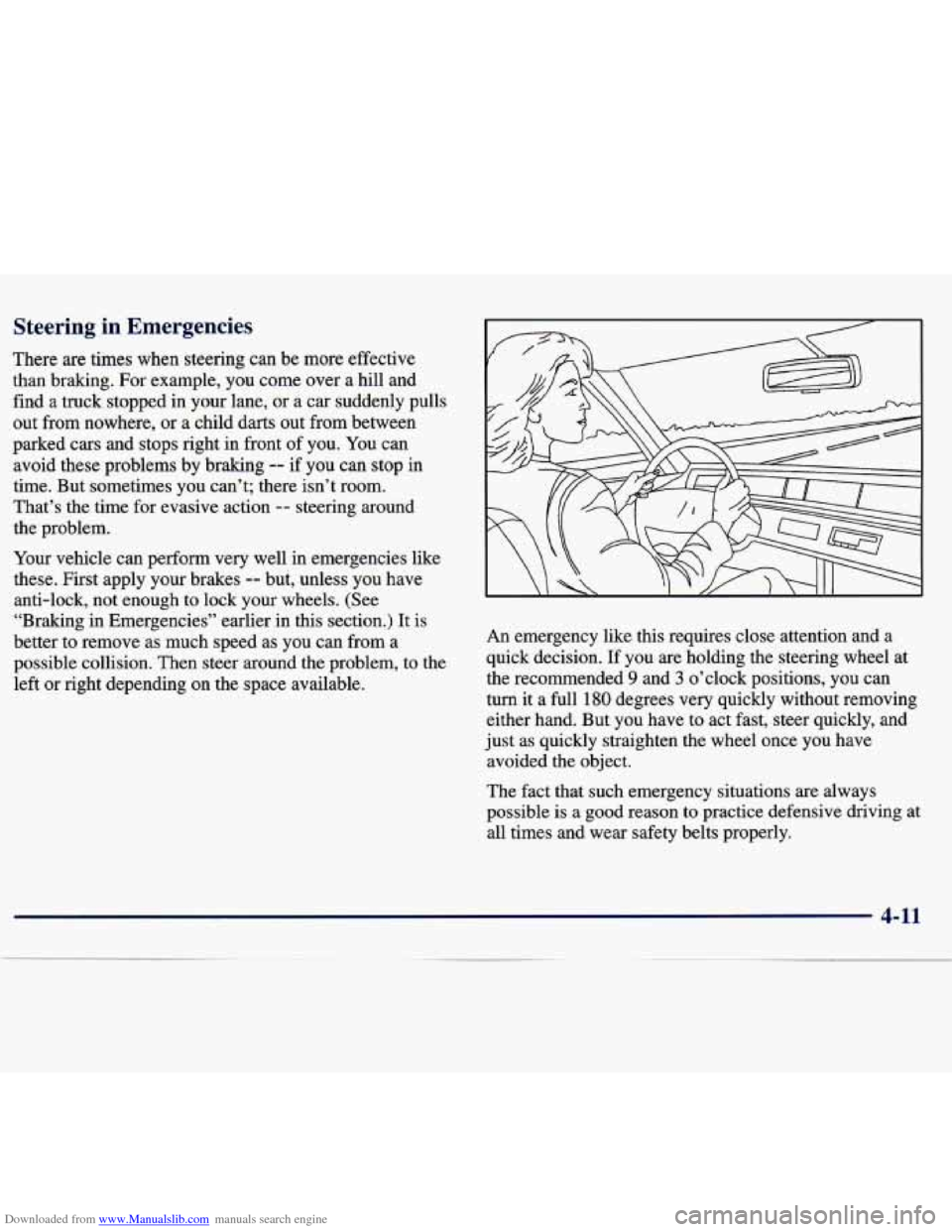
Downloaded from www.Manualslib.com manuals search engine Steering in Emergencies
There are times when steering can be more effective
than braking. For example, you come over a hill and
find a truck stopped in your lane,
or a car suddenly pulls
out from nowhere, or
a child darts out from between
parked cars and stops right in front of you.
You can
avoid these problems by braking
-- if you can stop in
time. But sometimes you can’t; there isn’t room.
That’s the time for evasive action
-- steering around
the problem.
Your vehicle can perform very well in emergencies like
these. First apply your brakes
-- but, unless you have
anti-lock, not enough to lock your wheels. (See
“Braking in Emergencies” earlier in this section.) It is
better to remove as much speed as you can from a
possible collision. Then steer around the problem, to the
left or right depending on the space available.
An emergency like this requires close attention and a
quick decision. If you are holding the steering wheel at
the recommended
9 and 3 o’clock positions, you can
turn it a full
180 degrees very quickly without removing
either hand. But you have to act fast, steer quickly, and
just as quickly straighten the wheel once you have
avoided the object.
The fact that such emergency situations are always
possible is a good reason to practice defensive driving at
all times and wear safety belts properly.
Page 375 of 386
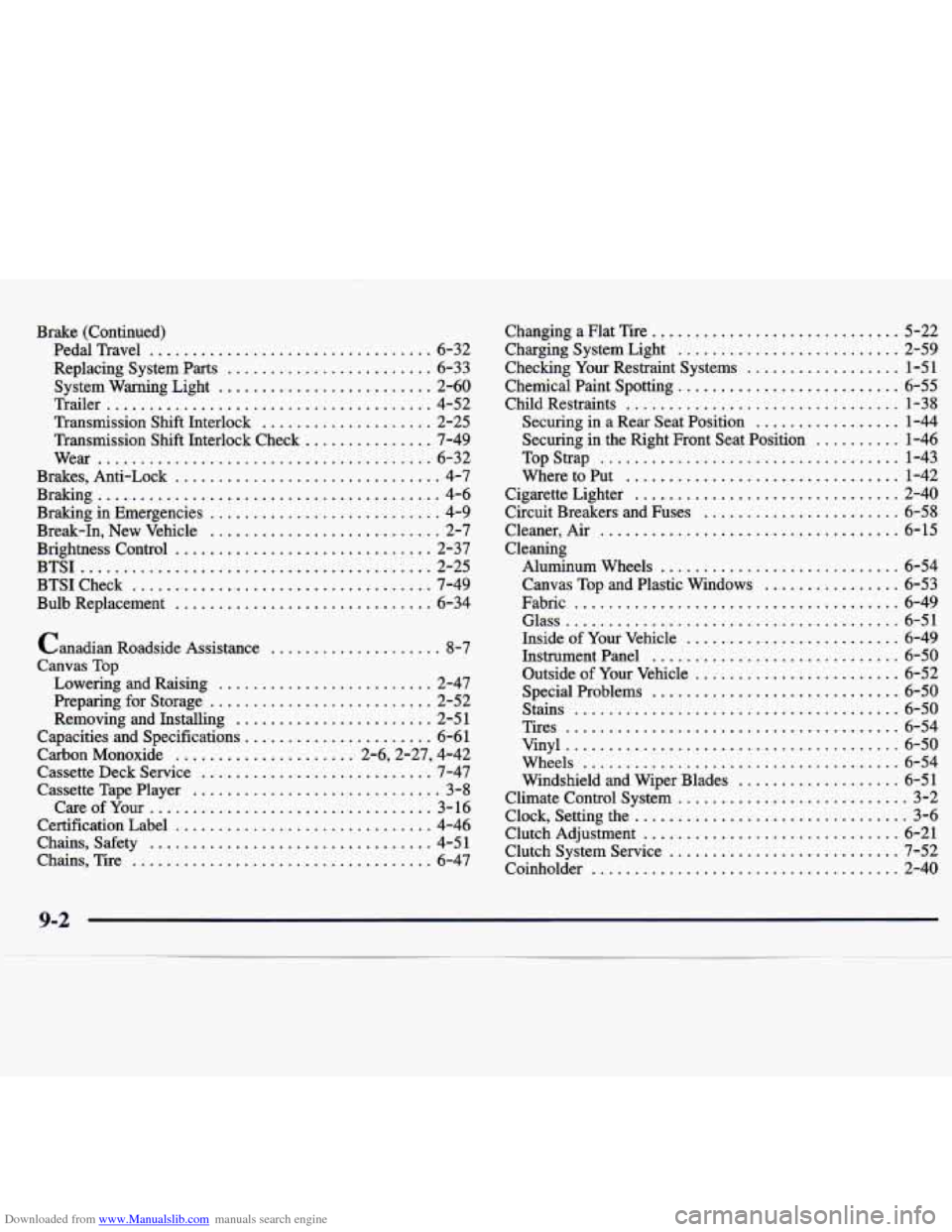
Downloaded from www.Manualslib.com manuals search engine Brake (Continued) Pedal Travel
................................. 6-32
Replacing System Parts
........................ 6-33
System Warning Light
......................... 2-60
Trailer
...................................... 4-52
Transmission Shift Interlock
.................... 2-25
Transmission Shift Interlock Check
............... 7-49
Wear
....................................... 6-32
Brakes. Anti-Lock
............................... 4-7
Braking in Emergencies
........................... 4-9
Break-In. New Vehicle
........................... 2-7
Brightness Control
.............................. 2-37
BTSICheck
................................... 7-49
Bulb Replacement
.............................. 6-34
Braking
........................................ 4-6
BTSI
......................................... 2-25
Canadian Roadside Assistance
.................... 8-7
Canvas Top
Lowering and Raising
......................... 2-47
Preparing for Storage
.......................... 2-52
Removing and Installing
....................... 2-51
Capacities and Specifications
...................... 6-61
Carbon Monoxide
..................... 2.6.2.27. 4.42
Cassette Deck Service
........................... 7-47
Cassette Tape Player
............................. 3-8
CareofYour
................................. 3-16
Certification Label
.............................. 4-46
Chains. Safety
................................. 4-51
Chains. Tire
................................... 6-47 Changing a Flat Tire
............................. 5-22
Charging System Light
.......................... 2-59
Checking Your Restraint Systems
.................. 1-51
Chemical Paint Spotting
.......................... 6-55
Child Restraints
................................ 1-38
Securing in a Rear Seat Position
................. 1-44
Securing in the Right Front Seat Position
.......... 1-46
Top Strap
................................... 1-43
Where to Put
................................ 1-42
Cigarette Lighter
............................... 2-40
Circuit Breakers and Fuses
....................... 6-58
Cleaner. Air
................................... 6-15
Cleaning Aluminum Wheels
............................ 6-54
Canvas Top and Plastic Windows
................ 6-53
Fabric
...................................... 6-49
Glass ....................................... 6-51
Inside of Your Vehicle
......................... 6-49
InstrumentPanel
............................. 6-50
Outside of
Your Vehicle ........................ 6-52
Special Problems
............................. 6-50
Stains
...................................... 6-50
Tires
....................................... 6-54
Vinyl
....................................... 6-50
Wheels
..................................... 6-54
Windshield and Wiper Blades
................... 6-51
Climate Control System
........................... 3-2
Clock. Setting the
................................ 3-6
Clutch Adjustment
.............................. 6-21
Clutch System Service
........................... 7-52
Coinholder
.................................... 2-40
Page 381 of 386
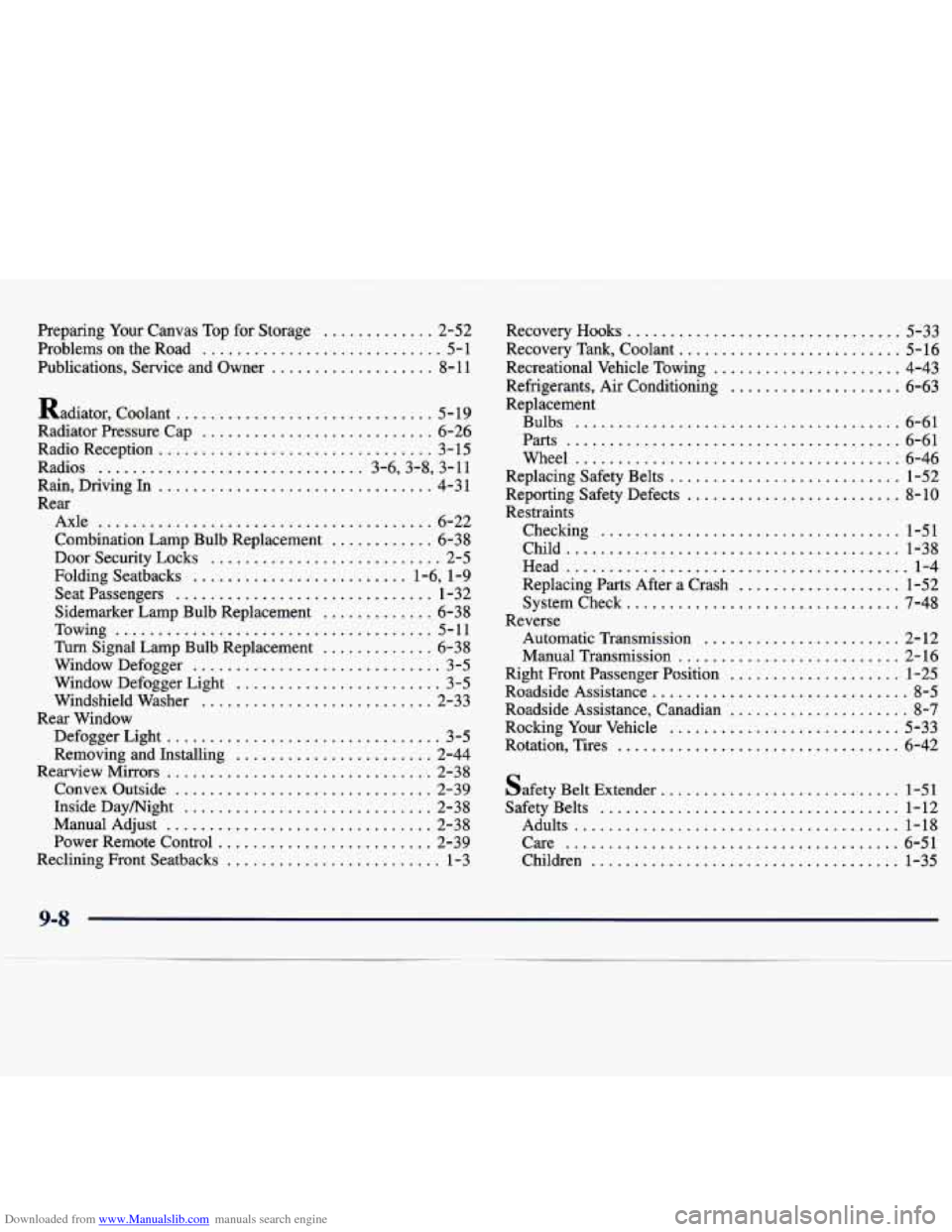
Downloaded from www.Manualslib.com manuals search engine Preparing Your Canvas Top for Storage ............. 2-52
Problems on the Road ............................ 5-1
Publications. Service and Owner
................... 8- 11
Radiator. Coolant
.............................. 5-19
Radiator Pressure Cap ........................... 6-26
Radios ............................... 3.6.3.8. 3.11
Rain. Driving In ................................ 4-31
Rear
Axle
....................................... 6-22
Door Security Locks ........................... 2-5
Folding Seatbacks ......................... 1.6. 1.9
Radio Reception
................................ 3- 15
Combination Lamp Bulb Replacement
............ 6-38
Seatpassengers .............................. 1-32
Sidemarker Lamp Bulb Replacement ............. 6-38
Towing ..................................... 5-11
Turn Signal Lamp Bulb Replacement ............. 6-38
Window Defogger ............................. 3-5
Window Defogger Light ........................ 3-5
Windshield Washer ........................... 2-33
Defogger Light ................................ 3-5
Removing and Installing ....................... 2-44
Rearview Mirrors ............................... 2-38
Convex Outside .............................. 2-39
Inside Daymight ............................. 2-38
Power Remote Control ......................... 2-39
Reclining Front Seatbacks ......................... 1-3
Rear Window
ManualAdjust
............................... 2-38
Recovery Hooks ................................ 5-33
Recovery Tank. Coolant .......................... 5-16
Recreational Vehicle Towing ...................... 4-43
Refrigerants. Air Conditioning .................... 6-63
Replacement
Bulbs
...................................... 6-61
Parts ....................................... 6-61
Wheel ...................................... 6-46
Replacing Safety Belts ........................... 1-52
Reporting Safety Defects ......................... 8-10
Restraints Checking
................................... 1-51
Child ....................................... 1-38
Head ........................................ 1-4
Systemcheck ................................ 7-48
Automatic Transmission ....................... 2-12
Manual Transmission .......................... 2-16
Right Front Passenger Position .................... 1-25
Roadside Assistance .............................. 8-5
Roadside Assistance. Canadian ..................... 8-7
Rocking Your Vehicle ........................... 5-33
Rotation. Tires ................................. 6-42
Replacing Parts After a Crash ................... 1-52
Reverse
safety Belt Extender ............................ 1-51
Safety Belts ................................... 1-12
Care ....................................... 6-51
Children .................................... 1-35
Adults
...................................... 1-18
9-8